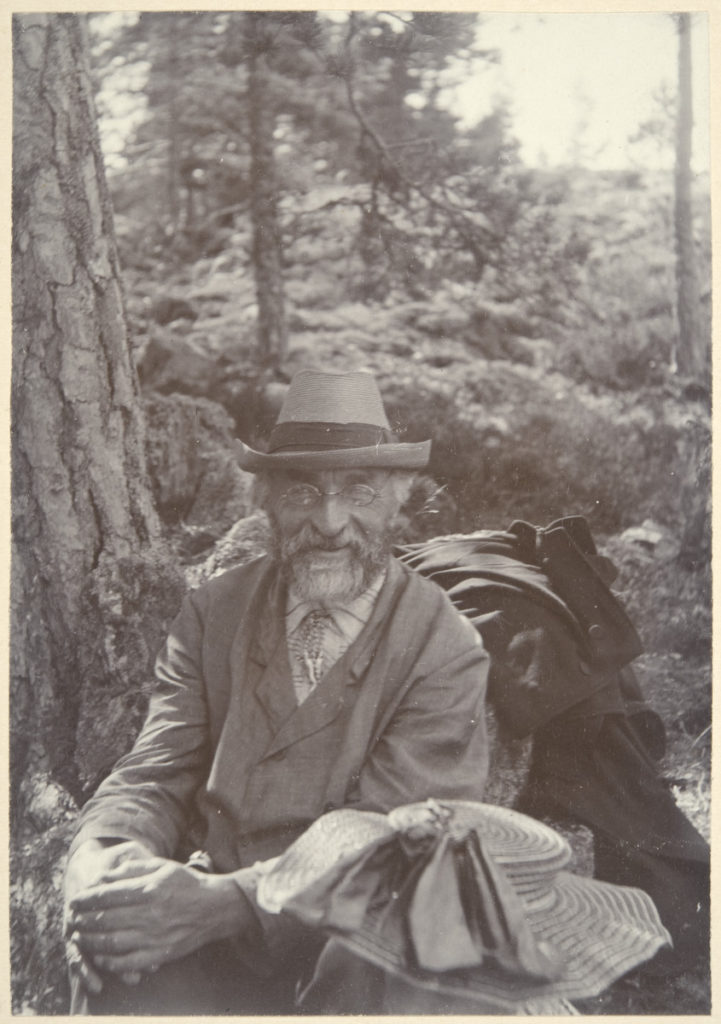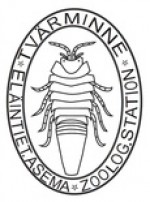
Tvärminne Zoological Station
The zoological station in Tvärminne was founded by zoology professor Johan Axel Palmén in 1902. His goal was to establish a marine field station in an area with a diverse environment and thus good opportunities for research. After his death, the position was transferred to the University of Helsinki as a testamentary donation in 1919.

Hausen, R., 1906. Museum Agency.
Ajatus syntyy
Aseman historia juontaa juurensa aina 1880-luvulle, jolloin Johan Axel Palmén, vapaaherra ja tuore Helsingin yliopiston eläintieteen professori, uudisti voimallisesti tieteenalansa opetusta. Jo nuorena dosenttina hän oli tuonut opetukseen anatomian kurssit, joilla perehdyttiin eri eläinryhmien rakenteeseen. Alkusyksyä lukuun ottamatta kursseille oli kuitenkin vaikea saada tuoretta materiaalia, semminkin merieläimiä, joiden leikkelyä Palmén piti erityisen tärkeänä ja opettavaisena. Toki hän oli matkoillaan kerännyt ja spriihin säilönyt kurssien tarpeisiin jopa valtamerien outoja elukoita, mutta ne korvasivat vain osittain talven aiheuttaman niukkuuden. Kuinka paljon helpompaa ja mielenkiintoisempaa opiskelijoiden olisikaan tutustua eri eläinlajeihin, niiden rakenteeseen ja elinympäristöihin kesällä vapaassa luonnossa kuin talvisin museoissa ja kurssisaleissa tai kirjoja pänttäämällä, Palmén järkeili. Olisiko mahdollista saada heidät käyttämään edes osan kesälomastaan eläintieteen opintoihin?
Eläintieteellinen kesälaboratorio 1889-1899
Professori Palmén oli viimeisen päälle tiedemies ja opettaja, intomielinen, mutta samalla tarmokas ja aina valmis uhraamaan aikaansa ja jopa varojaan edistääkseen tärkeinä pitämiään asioita. Tarjotakseen edes kaikkein lahjakkaimmille eläintieteen opiskelijoille ja nuorille tutkijoille mahdollisuuden harjoittaa opintoja ja tutkimusta myös kesäaikaan, hän vuokrasi vuonna 1889 Espoon Lehtisaaresta pari kalastajamökkiä vaatimattomaksi tutkimustukikohdaksi. Muutamassa vuodessa kesälaboratorioon, kuten tukikohtaa kutsuttiin, muodostui aktiivinen tiedeyhteisö, missä varttuneemmat ja pidemmälle ehtineet eläintieteilijät opettivat ja opastivat omien tutkimustensa lomassa nuorempiaan.
Saaren rantoja huuhtelevan vähäsuolaisen murtoveden eliöstä oli alusta alkaen keskeinen tutkimus- ja opetuskohde. Ja tutkittavaa toden totta riitti, sillä tietämys merialueidemme lajistosta oli kovin hataralla pohjalla. Pian huomattiin, että kalliosaarten runsaiden vesilammikoiden eliöstö oli toinen erityisen mielenkiintoinen aihe. Lammikothan olivat kuin luonnon muovaamia akvaarioita, jotka suorastaan houkuttelivat tutkijat lajittelemaan ja laskemaan niissä esiintyviä otuksia ja tekemään kokeitaan.
Palménin Tvärminne 1902-1919
Lehtisaaressa saavutetut erinomaiset tulokset saivat Palménin vakuuttuneeksi siitä, että kesä pitää hyödyntää niin opetuksessa kuin tutkimuksessa. Niinpä hän päätti muuttaa tilapäisen kesälaboratorionsa vakituiseksi kenttäasemaksi. Kun hän ei saanut ostaa Lehtisaarta, hän luopui paikasta 1899 ja alkoi etsiä uutta paikkaa. Hän saapui Tvärminneen Hankoniemeen 1901 ja löydettyään mieleisensä luonnonympäristön, hän osti sieltä asemaansa varten Krogartorpet nimisen torpan.
Toiminta Tvärminnen eläintieteellisellä asemalla alkoi keväällä 1902. Palmén itse omistautui täysin aseman käynnistämiseen ja huonokuntoisten rakennusten korjausten suunnitteluun, kun taas kolme nuorta tutkijaa – joista yksi ulkomaalainen- omistautuivat innokkaina tutkimukselleen: kalan loisiin, paikallisiin kasveihin ja värysmatoihin (turbellarians). Tämä kuvastaa kahta alusta asti asemalle luonteenomaista piirrettä: eläintieteeseen viittavasta nimestään huolimatta asema on yhtä lailla avoin myös muille kuin eläintieteilijöille ja ulkomaalaiset tutkijat ovat sinne aina tervetulleita.
Seuraavina vuosina rakennettiin uusia taloja kuten kaksikerroksinen laboratoriorakennus. Aseman alueet lisääntyivät lisäostojen myötä ja moottorivene ostettiin mahdollistamaan yhteydet rautatieasemalle ja siirtymiset ympäröivään saaristoon. Palmén rahoitti hankinnat omilla varoillaan. Tutkijoiden ja opiskelijoiden lukumäärä kasvoi ajan myötä. Vuonna 1909 kävi selväksi, että Lehtisaaren kesälaboratorion ajoilta periytynyt opetuskäytäntö vei kohtuuttomasti vanhempien tutkijoiden aikaa, ja asemalla järjestettiin ensimmäinen varsinainen kurssi.
Ensimmäiset vuosikymmenet yliopiston yksikkönä (1919-1969)
Tvärminnen eläintieteellinen asema siirtyi Palménin kuoltua testamenttilahjoituksena Helsingin yliopistolle ja nykyään se on osa bio- ja ympäristötieteellistä tiedekuntaa. Toinen maailmansota keskeytti aseman toiminnan maaliskuusta 1940 kesään 1945. Talvisodan jälkeen asema evakuoitiin, kun Neuvostoliitto ”vuokrasi” Hankoniemen 50 vuodeksi sotilastukikohdakseen, mutta joulukuussa 1941 se oli taas suomalaisten käsissä. Vuosikymmenen loppuun mennessä sota-ajan vauriot oli korjattu ja asema oli jälleen ahkerassa käytössä.
Kohti nykyaikaista, ympärivuotista tutkimusasemaa (1970-)
Koko 1960-luvun aseman käyttöaste oli kapasiteetin äärirajoilla. Kaksi puurakenteista valmistaloa hankittiin helpottamaan tilannetta, mutta oli selvää että asema tarvitsi kehittyäkseen uudet toimitilat. Vuosikymmenen lopulla yliopisto käynnisti uudisrakennushankkeen, jonka tuloksena asema sai neljä uutta tiilirakennusta, yhteispinta-alaltaan runsaat 6.000 m2. Uudet tilat otettiin käyttöön keväällä 1970. Jotta uusia tiloja voitaisiin tehokkaasti hyödyntää, asema sai vähitellen myös lisää henkilökuntaa ja uusia tutkimuslaitteita. Tärkeintä kuitenkin oli, että uudet rakennukset mahdollistivat aseman ympärivuotisen toiminnan. Tätä uutta ajanjaksoa leimasi tutkimuksen ja koulutustoiminnan huomattava lisääntyminen.
Juuri kun asema oli saanut uudet toimitilansa, sen olemassaolo joutui vaakalaudalle: Valtion omistama öljy-yhtiö Neste suunnitteli suuren öljynjalostamon perustamista vain neljän kilometrin päähän asemasta! Värikkään ”mediasodan” jälkeen, jossa luontoarvojen ja tutkimuksen puolustajat taistelivat teollisuuden ja talouselämän pyrkimyksiä vastaan, hallitus lopulta päätti iltakoulussaan kesäkuussa 1972, että tutkimuksen intressit olivat vahvemmat. Noihin aikoihin asema alkoi monitoroida maankäyttöä ja ympäristöasioita Hankoniemellä ja sitä ympäröivillä alueilla.
Aseman nykyisen rakennuskannan käyttöönoton jälkeen merentutkimus, tärkein aktiviteetti, on kokenut valtaisan muutoksen sen kehittyessä enemmän kohti laboratoriopainotteisempaa tiedettä ja kokeellisten tutkimusten tullessa yhä tärkeämmiksi. Voidakseen vastata ajan haasteisiin ja nykyaikaisen tutkimuksen vaatimuksiin asema toteutti talvella 1997–98 päärakennuksen tutkimustilojen perusteellisen saneerauksen ja uudelleenorganisoinnin. Lisäksi rakennettiin kaksi kokonaan uutta rakennusta kokeellisen tutkimuksen tarpeisiin. Syksyllä 2021 seuraava peruskorjaus alkoi, jossa uudistetaan mm. akvaariotiloja päärakennuksessa.

